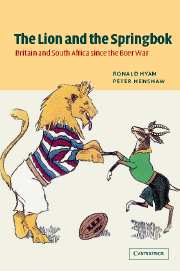Book contents
- Frontmatter
- Contents
- List of illustrations
- List of tables
- Preface
- Acknowledgements
- List of abbreviations
- 1 The uneasy special relationship: dynamics and divergencies
- 2 Breakdown: into war, 1895–1899
- 3 Post-war: the myth of magnanimity, 1905–1907
- 4 African interests and the South Africa Act, 1908–1910
- 5 ‘Greater South Africa’: the struggle for the High Commission Territories, 1910–1961
- 6 The economic dimension: South Africa and the sterling area, 1931–1961
- 7 Britain, the United Nations, and the ‘South African disputes’, 1946–1961
- 8 The political consequences of Seretse Khama and Ruth, 1948–1952
- 9 Containing Afrikanerdom: the geopolitical origins of the Central African Federation, 1948–1953
- 10 Strategy and the transfer of Simon's Town, 1948–1957
- 11 The parting of the ways: the departure of South Africa from the Commonwealth, 1951–1961
- 12 Enfeebled lion? How South Africans viewed Britain, 1945–1961
- 13 Springbok reviled: some British reactions to apartheid, 1948–1994
- Epilogue The relationship restored: the return of the new South Africa to the Commonwealth, 1994
- Select bibliography
- Index
1 - The uneasy special relationship: dynamics and divergencies
Published online by Cambridge University Press: 03 December 2009
- Frontmatter
- Contents
- List of illustrations
- List of tables
- Preface
- Acknowledgements
- List of abbreviations
- 1 The uneasy special relationship: dynamics and divergencies
- 2 Breakdown: into war, 1895–1899
- 3 Post-war: the myth of magnanimity, 1905–1907
- 4 African interests and the South Africa Act, 1908–1910
- 5 ‘Greater South Africa’: the struggle for the High Commission Territories, 1910–1961
- 6 The economic dimension: South Africa and the sterling area, 1931–1961
- 7 Britain, the United Nations, and the ‘South African disputes’, 1946–1961
- 8 The political consequences of Seretse Khama and Ruth, 1948–1952
- 9 Containing Afrikanerdom: the geopolitical origins of the Central African Federation, 1948–1953
- 10 Strategy and the transfer of Simon's Town, 1948–1957
- 11 The parting of the ways: the departure of South Africa from the Commonwealth, 1951–1961
- 12 Enfeebled lion? How South Africans viewed Britain, 1945–1961
- 13 Springbok reviled: some British reactions to apartheid, 1948–1994
- Epilogue The relationship restored: the return of the new South Africa to the Commonwealth, 1994
- Select bibliography
- Index
Summary
Of all the regions of the world where imperial Britain sought to exert influence, none exhibited more contradictions, and therefore such intractable dilemmas and frustrations, as South Africa. Cape Colony was conquered from the Dutch in 1806 and retained in 1815 because of its strategic importance on the route to India. Control of the hinterland inevitably followed. Britain thus acquired a foreign settler community of some 40,000, who resented a more intrusive government than they were used to and doctrines of race relations which seemed to them wrong-headed. Many Boers trekked into the interior from the 1830s, determined to assert their right to a quiet sweet life (lekke lewe) of their own choosing, free from interference, and to preserve what they regarded as ‘proper relations between master and servant’. The fundamental constitution (grondwet) of the South African Republic (Transvaal) made their intransigent Bantu policy all too plain (clause 9): ‘The people will admit no equalising (gelijkstelling) between the white and coloured inhabitants whether in church or state’ (February 1858). It was not simply that the Boers would not accept or admit black equality (for which the word would have been gelijkheid), but, more uncompromisingly, no assimilation, no making equal or treating as if equal. Treks enormously enlarged the area of contact and potential conflict on the highveld with spirited and sometimes highly mobile African chiefdoms determined to resist subjection.
- Type
- Chapter
- Information
- The Lion and the SpringbokBritain and South Africa since the Boer War, pp. 1 - 36Publisher: Cambridge University PressPrint publication year: 2003



